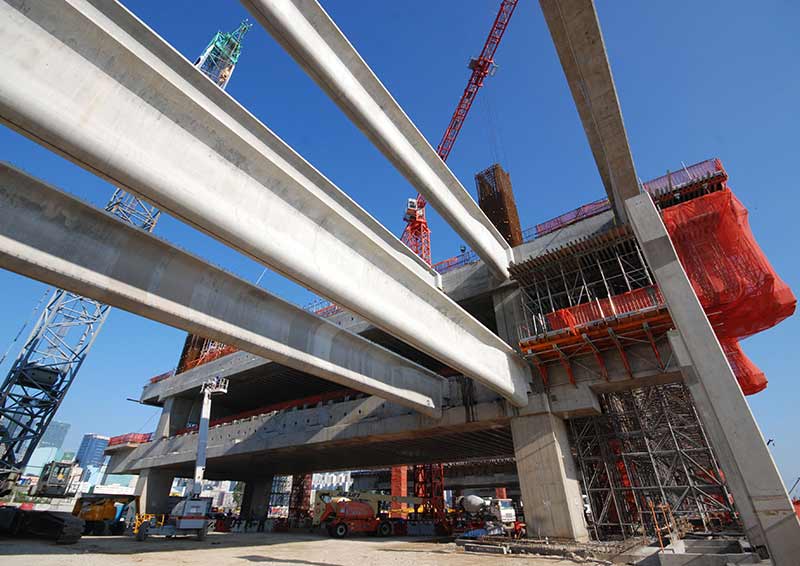Agile construction
[edit] Introduction
In general, the term ‘agile’ means the ability to move swiftly and with ease. In construction, it can be used to describe items of plant that are specified for certain tasks due to being particularly capable of operating quickly and easily.
It can also be used in relation to agile infrastructure, which is infrastructure that is responsive and can adapt to the changing needs of the user.
More specifically though, agile can relate to a method of project management, often known as ‘Agile construction’. This is a process developed from agile manufacturing and project management, particularly that developed by the Toyota Production System, and applied to construction with the intention of dividing tasks and activities into short work phases, allowing productivity to be measured and improved. Agile construction techniques include prefabrication and supply chain management.
Agile construction utilises real-time input from the source of the work information to measure productivity and provide feedback. This allows for changes to be made each time the process is repeated to improve upon it and remove the elements that are inefficient, unproductive or wasteful. This means that a contractor is able to rapidly adapt to changes both on- and off-site, increase accuracy, and ultimately provide better value to the client.
Agile thinking tends to be innovative, responsive and flexible and focusses on delivering value. It is a positive mindset that does not condemn failure but uses it to generate feedback.
[edit] Other definitions
NB Inclusive design in essential services. A practical guide for firms and suppliers, written by Bailey Kursar for the Money Advice Trust and Fair By Design and published in 2021, suggests: ‘The concept of Agile development encompasses an adaptable, collaborative and iterative way of planning, developing and delivering work. It was popularised by the Manifesto for Agile Software Development https://agilemanifesto.org/.
Functional Standards Common Glossary, published by the Cabinet Office, states: ‘Agile is an approach to software development that can also be used in different project management contexts. It emphasises building quickly, testing and iterating work based on regular feedback.’
The Association for Project Management (APM) Agile Glossary defines agile as: ‘…a project management approach based on delivering requirements iteratively and incrementally throughout the life cycle.’
It defines an agile development as: '...an umbrella term specifically for iterative software development methodologies. Popular methods include Scrum, Lean, DSDM (Dynamic System Development Method) and eXtreme Programming (XP).'
[edit] Related articles on Designing Buildings
- Advanced manufacturing.
- Agile manifesto.
- Big data from smart infrastructure.
- Dynamic conditions for project success.
- Increasing productivity in 2018.
- Infrastructure Transformation.
- Lean construction.
- Lean construction - a quality perspective.
- Logistics management.
- Prefabrication.
- Quality Management System.
- Resource management.
- Scaled agile.
- Supply chain management.
- Understanding agile in project management.
Featured articles and news
CIOB report; a blueprint for SDGs and the built environment
Pairing the Sustainable Development Goals with projects.
Latest Build UK Building Safety Regime explainer published
Key elements in one short, now updated document.
UKGBC launch the UK Climate Resilience Roadmap
First guidance of its kind on direct climate impacts for the built environment and how it can adapt.
CLC Health, Safety and Wellbeing Strategy 2025
Launched by the Minister for Industry to look at fatalities on site, improving mental health and other issues.
One of the most impressive Victorian architects. Book review.
Common Assessment Standard now with building safety
New CAS update now includes mandatory building safety questions.
RTPI leader to become new CIOB Chief Executive Officer
Dr Victoria Hills MRTPI, FICE to take over after Caroline Gumble’s departure.
Social and affordable housing, a long term plan for delivery
The “Delivering a Decade of Renewal for Social and Affordable Housing” strategy sets out future path.
A change to adoptive architecture
Effects of global weather warming on architectural detailing, material choice and human interaction.
The proposed publicly owned and backed subsidiary of Homes England, to facilitate new homes.
How big is the problem and what can we do to mitigate the effects?
Overheating guidance and tools for building designers
A number of cool guides to help with the heat.
The UK's Modern Industrial Strategy: A 10 year plan
Previous consultation criticism, current key elements and general support with some persisting reservations.
Building Safety Regulator reforms
New roles, new staff and a new fast track service pave the way for a single construction regulator.
Architectural Technologist CPDs and Communications
CIAT CPD… and how you can do it!
Cooling centres and cool spaces
Managing extreme heat in cities by directing the public to places for heat stress relief and water sources.
Winter gardens: A brief history and warm variations
Extending the season with glass in different forms and terms.
Restoring Great Yarmouth's Winter Gardens
Transforming one of the least sustainable constructions imaginable.
























